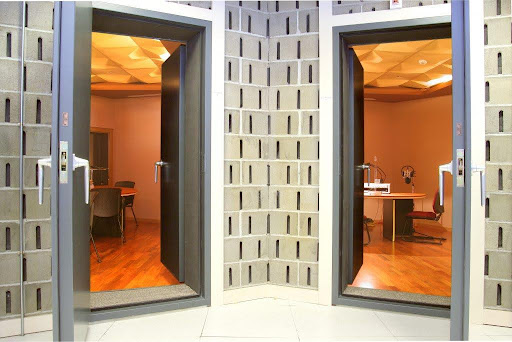
Acoustic doors appear in many exciting and varied locations, unlocking the potential to bring new experiences straight to your doorstep.
In this blog post we take an intimate look at 6 of the best real-world applications of acoustic doors – each sure to give you a top-notch experience!
1. Soundproofing Music Venues
Soundproofing music venues is a great utilization of acoustic doors, as they are capable of significantly reducing noise from both outside and inside the venue. Not only do they act as preventative measures against disturbances, but they can also buffer out distractions allowing performers to easily play or record their work in peace.
Using acoustic door systems has been found to be incredibly effective in creating an atmosphere which prioritizes quality audio capture while ensuring that no interference enters into the chamber – this makes them perfect for recording professionals who require exceptional soundproofing within their studio to truly capture pristine results.
They can even create environmental insulation by providing robust temperature control throughout large indoor spaces like concert halls or theatres where performances take place on a regular basis. Consequently, acoustic doors provide multiple benefits when applied correctly making them one of the most sought after solutions for soundproofing music venues today!
2. Securing Safe Rooms in Financial Institutions
Acoustic doors are becoming increasingly popular due to their security capabilities, with financial institutions taking advantage of this. Securing safe rooms in these settings is one of the foremost uses of such doors as they are capable of blocking outside sound while still allowing personnel inside to communicate usually and receive assistance if needed.
Acoustic doors feature a range of characteristics that set them apart from standard models including an improved level of insulation which reduces both airborne and impact noise, thereby bolstering the existing safety protocols already in place at banks and other monetary establishments.
Advanced access control systems also allow for heightened user management via digital keys or biometric readers making sure no unauthorized individuals can enter secure areas – often accessible only after multiple stages of authentication have been completed successfully.
This makes acoustic doors perfect for sensitive areas where high levels protection are essential, providing ultimate peace-of-mind for everyone inside and out.
3. Moderating Climate Control in Industrial Facilities
Moderating climate control in industrial facilities stands out as one of the most advantageous applications of acoustic doors. This is because these structures actively reduce airborne noise and vibration contamination while simultaneously partnering with High-Density Fiberglass panels to fortify soundproofing capabilities from the inside.
Furthermore, they effectively contour to designated spaces, ensuring temperatures remain both optimal and consistent throughout large areas. Additionally, these eco-friendly solutions simplify energy usage via advanced insulation components which can save up to 40% on heating costs within enclosed environments when compared against conventional door materials such as wood or steel.
All in all, acoustic doors serve a vital role for moderating climates by offering an enhanced level of temperature retention with sustainable construction – making them an invaluable addition to any convenient workspace.
4. Improving Acoustic Performance of Office Buildings
Improving acoustic performance of office buildings is a rigorous challenge for many modern businesses. To ensure the safety and comfort of their occupants, acoustic doors are an ideal solution to reduce distracting outside noise and achieve better acoustic insulation.
These door systems feature heavier doors with improved gaskets as well as soundproof core materials like steel laminates and resinous foam which improve both sound attenuation and transmission loss to provide significant acoustic reduction inside workspaces.
With this in mind, they can also help protect workers from health hazards caused by excessive levels of reverberation or environmental noise pollution present in some offices.
In sum, using quality installation techniques paired with secure components such as fire door seals ensures that these types of doors deliver effective results when it comes to improving the acoustics in closed spaces – making them one of the best applications available on the market right now!
5. Reducing Unwanted Noise from Medical Settings
Reducing unwanted noise from medical settings is a noble cause that can be achieved effectively by the use of acoustic doors. By carefully surveying soundscapes to evaluate current levels and behaviours, refined door designs are generated with distinct acoustic properties tailored to actively reduce ambient noise.
These warm-sounding barriers affixed with vibrational absorbing components can silence a variety of decibels while preserving essential notification cues within healthcare environments. When factoring in its cost-efficiency compared to other mitigation tools such as double glazed windows, it’s evident why acoustic door technology has become one of the foremost antiviral fixtures.
Thus, integrating these innovative apparatuses into existing infrastructure proves an economical method for curtailing excessive auditory disturbances often deemed worryingly distracting within medical spaces – setting new standards in terms of comfortability and peace of mind wherever they’re installed.
6. Music Practice Rooms
Music Practice Rooms are a prime example of acoustic doors in practice. Employing superior soundproofing properties that create a fully insulated sound chamber, these specialized doors effectively block out all intrusive background noise to ensure undisturbed music sessions and auditions.
This makes them perfect for musicians looking to record audio tracks without any disruptive interference or bothersome echoing tones reverberating within the room. Additionally, they feature baresque ratings ranging up to STC 33 which means they’re also great at keeping external sounds from invading musical performances.
All in all, their ingenious blend of modern technology and acoustic engineering make Music Practice Rooms a highly sought-after commodity amongst those who wish to practice music with complete concentration away from unwanted disturbances.
The Bottom Line
In conclusion, the above-mentioned applications of acoustic doors offer practical solutions to some common sonic nuisances.
From soundproof recording studios for perfect music production to enclosing large concert halls, these doors are a must-have.
With dependable quality, performance and cost-efficiency combined with style – you don’t have to compromise on either!








